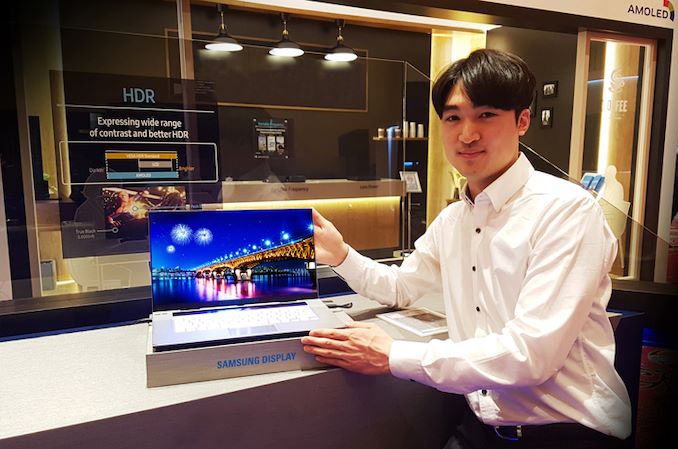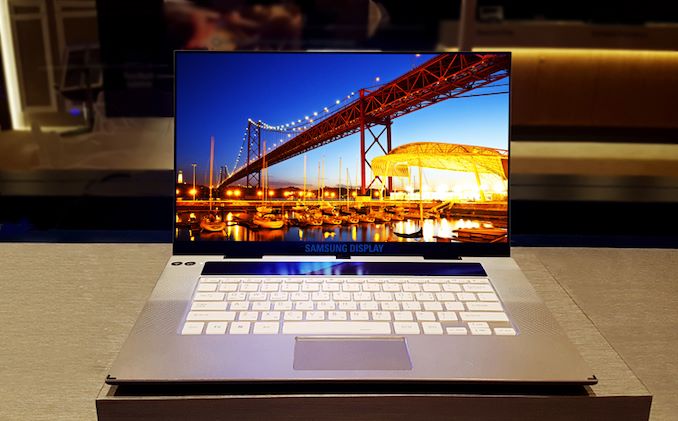Samsung Unveils 15.6-Inch Ultra-HD OLED Display for Laptops
by Anton Shilov on January 24, 2019 12:00 PM EST
Samsung has announced its 15.6-inch OLED monitor for notebooks. The Ultra-HD display features very advanced specs, will go into mass production next month, and will be used by leading makers of high-end notebooks later this year.
The Samsung 15.6-inch OLED monitor for notebooks relies on an Ultra-HD (3840×2160) OLED panel that boasts with a brightness level ranging from 0.0005 to 600 nits, a dynamic contrast ratio of 120,000:1, a very low response time, and wide horizontal viewing angles. The display can reproduce 100% of the DCI-P3 color gamut, which is considerably more more accurate when compared to LCDs available today. Furthermore, the monitor carries VESA’s DisplayHDR True Black badge thus supporting at least HDR10 spec.
| Specifications of Samsung's 15.6-Inch OLED Panel | |
| Specs | |
| Panel | 15.6" OLED |
| Native Resolution | 3840 × 2160 |
| Maximum Refresh Rate | ? |
| Response Time | unknown |
| Brightness | 0.0005 to 600 cd/m² |
| Contrast | 120,000:1 |
| Viewing Angles | ? |
| HDR | DisplayHDR True Black, HDR10 |
| Pixel Pitch | 0.0899 mm² |
| Pixel Density | 282 ppi |
| Display Colors | ? |
| Color Gamut Support | DCI-P3: 100% |
| Aspect Ratio | 16:9 |
| Mass Production Start | Mid-February-2019 |
An added bonus of any OLED monitor are very narrow display bezels, which will enable makers of notebooks to further miniaturize their 15.6-inch class laptops. In the meantime, keep in mind that the OLED technology is not ideal and has its own weaknesses, including off-axis color shifting, ghosting, burn-in, and other. So, only time will tell how good the new display from Samsung is.
Samsung will start mass production of its 15.6-inch OLED monitors for laptops in mid-February, so expect actual notebooks that use the display to hot the market later this year.
Back at CES, Lenovo and HP announced plans to use 15.6-inch AMOLED panels with their premium laptops in 2019, but did not confirm the source of their monitors.
Related Reading
- Lenovo at CES 2019: Yoga C730 Gets AMOLED Display
- HP at CES 2019: HP Spectre x360 15 Gets AMOLED Display
- Dell at CES 2019: Alienware 55-Inch 4K 120 Hz OLED Gaming Monitor Showcased
- New 8K OLED Displays for Tablets and Laptops: 8.3 and 13.3 Inches
- CES 2019: LG Announces Signature OLED TV R - A Rollable TV
- Lenovo Launches ThinkPad X1 Yoga At CES With OLED Display
- JOLED Demos 21.6-Inch OLED Monitor for Gamers
Source: Samsung











38 Comments
View All Comments
sleepeeg3 - Thursday, January 24, 2019 - link
This sounds awesome! It's about time. After PC laptops suffered through years of awful 1366x768 TN displays, they finally start making exponential leaps from HD IPS panels to 4K OLED! If any displays needed improved PPI, it was most definitely laptops. Much more productive to use, when you can cram in more content, while actually having the contrast and resolution to see it.ajp_anton - Thursday, January 24, 2019 - link
"features very advanced specs""a dynamic contrast ratio of 120,000:1"
Something's not right here.
boozed - Thursday, January 24, 2019 - link
Notwithstanding the calculation error (based on the figures quoted, it should be 1,200,000:1), is the marketing term "dynamic contrast ratio" even meaningful for OLED? Isn't that just its standard contrast ratio, without any trickery?Santoval - Friday, January 25, 2019 - link
I believe you are correct. OLED panels have no need for "dynamic contrast ratio" BS, so that must be static contrast ratio.philehidiot - Wednesday, January 30, 2019 - link
Shouldn't OLEDs theoretically have an infinite contrast ratio as black is off and therefore zero? Or do they measure scatter, reflection and refraction and so on within the screen?iwod - Thursday, January 24, 2019 - link
Burn -In?PWM?
sleepeeg3 - Thursday, January 24, 2019 - link
Has that ever been a problem? Millions of phones would say, "no."Never fails - there are always people trying to bring down better display technologies like plasma or OLED, all in the name of defending their craptacular tech that they bought to save a few $.
Average person spends probably 8 hours / day staring at a screen. That's 1/3 of your life. Buy something easy on your eyes.
name99 - Thursday, January 24, 2019 - link
I get where you are coming from. But different use cases are different.It's pretty much impossible (and there's very little demand) to hack a phone to keep the screen on and displaying the same static content for hours on end. Whereas there are use cases (and it's generally just a trip to the Settings app) for setting up a laptop that behaves this way.
Compare, eg, the Tesla. I don't know what tech that screen is, but burn-in on Tesla screens (especially the menu bar area) is not uncommon.
Maybe Tesla just didn't care? But more likely, I suspect, is that they figured the tech they're using worked fine on tablets, so what's the difference? Didn't take into account:
(a) car can be much hotter for a long time (I don't know if that's relevant)
(b) car screen is on, with unchanging image (especially the menu bar) for hours on end, day after day (I'm sure this is VERY relevant).
Byte - Tuesday, January 29, 2019 - link
I see samsung phones all day long with SBI. I guess they crash a lot and stuck screen.philehidiot - Wednesday, January 30, 2019 - link
A friend of mine used an S7 as a satnav for long distance and got quite bad screen burn. I gave him my old M9 with an LCD screen to use for the purpose.As for heat, he was also charging the phone at the same time and noted it got very hot. Possibly a factor as above.